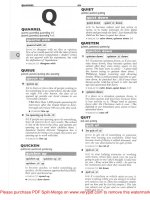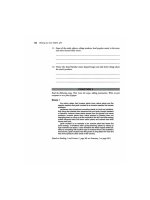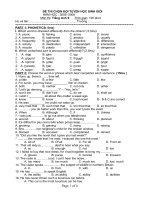Reading comprehention 9 ppt
Bạn đang xem bản rút gọn của tài liệu. Xem và tải ngay bản đầy đủ của tài liệu tại đây (95.56 KB, 6 trang )
W
hen Lesson 1 talked about establishing the facts—the who, what, when, where, and how—it
omitted one very important question: Why? Now you’re ready to tackle that all-important question.
Just as there’s a motive behind every crime, there’s also a “motive”behind every piece of writing.
All writing is communication: A writer writes to convey his or her thoughts to an audience, the reader: you.
Just as you have something to say (a motive) when you pick up the phone to call someone, writers have some-
thing to say (a motive) when they pick up a pen or pencil to write. Where a detective might ask, “Why did the but-
ler do it?” the reader might ask, “Why did the author write this? What idea is he or she trying to convey?” What
you’re really asking is, “What is the writer’s main idea?”
Finding the main idea is much like finding the motive of the crime. It’s the motive of the crime (the why)
that usually determines the other factors (the who, what, when, where, and how). Similarly, in writing, the main
idea also determines the who, what, when, and where the writer will write about, as well as how he or she will write.
LESSON
Finding the
Main Idea
LESSON SUMMARY
A detective finds the facts to determine “whodunit” and what the motive
was. A reader determines the facts not only for their own sake but also
to find out why the author is writing: What’s the main idea? This lesson
shows you how to determine the main idea of what you read.
2
27
Subject vs. Main Idea
There’s a difference between the subject of a piece of
writing and its main idea. To see the difference, look
again at the passage about the postal system. Don’t
skip over it! You read it in Lesson 1, but please read it
again, and read it carefully.
Today’s postal service is more efficient and reliable
than ever before. Mail that used to take months to
move by horse and foot now moves around the
country in days or hours by truck, train, and plane.
First-class mail usually moves from New York City
to Los Angeles in three days or less. If your letter or
package is urgent, the U.S. Postal Service offers Pri-
ority Mail and Express Mail services. Priority Mail is
guaranteed to go anywhere in the United States in
two days or less. Express Mail will get your package
there overnight.
You might be asked on a standardized test, “What
is the main idea of this reading?”
For this passage, you might be tempted to answer:
“the post office.”
But you’d be wrong.
This passage is about the post office, yes—but
“the post office” is not the main idea of the passage.
“The post office” is merely the subject of the passage
(who or what the passage is about). The main idea
must say something about this subject. The main idea
of a text is usually an assertion about the subject. An
assertion is a statement that requires evidence (“proof”)
to be accepted as true.
The main idea of a passage is an assertion about
its subject, but it is something more: It is the idea that
also holds together or controls the passage. The other
sentences and ideas in the passage will all relate to that
main idea and serve as “evidence” that the assertion is
true. You might think of the main idea as a net that is
cast over the other sentences. The main idea must be
general enough to hold all of these ideas together.
Thus, the main idea of a passage is:
■
An assertion about the subject
■
The general idea that controls or holds together
the paragraph or passage
Look at the postal service paragraph once more.
You know what the subject is: “the post office.” Now, see
if you can determine the main idea. Read the passage
again and look for the idea that makes an assertion
about the postal service and holds together or controls
the whole paragraph. Then answer the following
question:
1. Which of the following sentences best summa-
rizes the main idea of the passage?
a. Express Mail is a good way to send urgent
mail.
b. Mail service today is more effective and
dependable.
c. First-class mail usually takes three days or less.
Because a is specific—it tells us only about Express
Mail—it cannot be the main idea. It does not encompass
the rest of the sentences in the paragraph—it doesn’t
cover Priority Mail or first-class mail. Answer c is also
very specific. It tells us only about first class mail, so it,
too, cannot be the main idea.
But b—“Mail service today is more effective and
dependable”—is general enough to encompass the
whole passage. And the rest of the sentences support
the idea that this sentence asserts: Each sentence offers
“proof” that the postal service today is indeed more
efficient and reliable. Thus, the writer aims to tell us
about the efficiency and reliability of today’s postal
service.
– FINDING THE MAIN IDEA–
28
Topic Sentences
You’ll notice that in the paragraph about the postal
service, the main idea is expressed clearly in the first
sentence: “Today’s postal service is more efficient
and reliable than ever before.” A sentence, such as this
one, that clearly expresses the main idea of a para-
graph or passage is often called a topic sentence.
In many cases, as in the postal service paragraph,
the topic sentence is at the beginning of the paragraph.
You will also frequently find it at the end. Less often, but
on occasion, the topic sentence may be in the middle of
the passage. Whatever the case, the topic sentence—like
“Today’s postal service is more efficient and reliable
than ever before”—is an assertion, and it needs “proof.”
The proof is found in the facts and ideas that make up
the rest of the passage. (Not all passages provide such
a clear topic sentence that states the main idea. Less
obvious passages will come up in later lessons.)
Practice in Identifying Topic
Sentences
Remember that a topic sentence is a clear statement of
the main idea of a passage; it must be general enough
to encompass all the ideas in that passage, and it usu-
ally makes an assertion about the subject of that pas-
sage. Knowing all that, you can answer the following
question even without reading a passage.
Practice 1
2. Which of the following sentences is general
enough to be a topic sentence?
a. The new health club has a great kickboxing
class.
b. Many different classes are offered by the
health club.
c. Pilates is a popular class at the health club.
d. The yoga class is offered on Saturday
mornings.
The answer is b, “Many different classes are
offered by the health club.” Answers a, c, and d are all
specific examples of what is said in b, so they are not
general enough to be topic sentences.
Practice 2
Now look at the following paragraph. Underline the
sentence that expresses the main idea, and notice how
the other sentences work to support that main idea.
Erik always played cops and robbers when he was a
boy; now, he’s a police officer. Suzanne always played
school as a little girl; today, she is a high-school
math teacher. Kara always played store; today, she
owns a chain of retail clothing shops. Long before
they are faced with the question, “What do you want
to be when you grow up?” some lucky people know
exactly what they want to do with their lives.
Which sentence did you underline? You should
have underlined the last sentence: “Long before they are
faced with that question ‘What do you want to be when
you grow up?’ some lucky people know exactly what
they want to do with their lives.” This sentence is a
good topic sentence; it expresses the idea that holds
together the whole paragraph. The first three
sentences—about Erik, Suzanne, and Kara—are specific
examples of these lucky people. Notice that the topic
sentence is found at the end of the paragraph.
– FINDING THE MAIN IDEA–
29
Practice 3
Among the following eight sentences are two topics
sentences. The other sentences are supporting sen-
tences. Circle the two topic sentences. Then write the
numbers of the supporting sentences that go with each
topic sentence.
1.
Finally, there is a concierge on duty 24 hours a day.
2. Some police offer duties, like writing reports,
have no risk at all.
3. For example, there is a pool on the top floor.
4. Not all police duties are dangerous.
5. Others, like traffic duty, put police officers at very
little risk.
6. Tenants of the luxury apartment building enjoy
many amenities.
7. Still other duties, like investigating accidents,
leave officers free of danger.
8. In addition, the lobby has a dry cleaner, an ATM
machine, and a coffee shop.
Sentences 4 and 6 are the two topic sentences
because both make an assertion about a general subject.
The supporting sentences for topic sentence 4, “Not all
police duties are dangerous,” are sentences 2, 5, and 7.
The supporting sentences for topic sentence 6, “Tenants
of the luxury apartment building enjoy many ameni-
ties,” are the remaining sentences 1, 3, and 8.
Here’s how they look as paragraphs:
Not all police duties are dangerous. Some duties, like
writing reports, have no risk at all. Others, like traf-
fic duty, offer very little risk. Still other duties, like
investigating accidents, leave officers free of danger.
Tenants of the luxury apartment building enjoy
many amenities. For example, there is a pool on the
top floor. In addition, the lobby has a dry cleaner, an
ATM machine, and a coffee shop. Finally, there is a
concierge on duty 24 hours a day.
You might have noticed the supporting sentences
in the first paragraph about police duties begin with the
following words: some, others, and still other. These
words are often used to introduce examples. The sec-
ond paragraph uses different words, but they have the
same function: for example, in addition, and finally. If
a sentence begins with such a word or phrase, that is a
good indication it is not a topic sentence—because it is
providing a specific example.
Here are some words and phrases often used to
introduce specific examples:
If you’re having trouble finding the main idea of
a paragraph, you might try eliminating the sentences
that you know contain supporting evidence.
Summary
Now you can answer the last question—the why. What
is the writer’s motive? What’s the main idea he or she
wants to convey? By finding the sentence that makes an
assertion about the subject of the paragraph and that
encompasses the other sentences in the paragraph, you
can uncover the author’s motive.
For example
For instance
In addition
Furthermore
In particular
Some
Others
– FINDING THE MAIN IDEA–
30
– FINDING THE MAIN IDEA–
31
■
A paragraph, by definition, is a group of sentences about the same idea. As you read today and the rest
of the week, notice how texts are divided into paragraphs. What idea holds each paragraph together?
Can you identify any topic sentences?
■
Formulate topic sentences about things that you come across in your day. Make assertions about these
people, places, and things. For example, you may eat in the cafeteria every day. Make an assertion about
it: “This cafeteria needs remodeling,” for example. Or, make an assertion about a coworker: “June is a
very hard worker,” you might say. Then, support your assertions. What “evidence” could you supply
for your paragraph? Why do you say the cafeteria needs remodeling? Is there paint peeling off the walls?
Is it still decorated 60s style? Is it not wheelchair accessible? What evidence do you have that June is
a hard worker? Is she always at her computer? Does she ask informed questions in staff meetings?
Does she look like she needs more sleep?
Skill Building until Next Time









